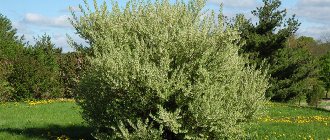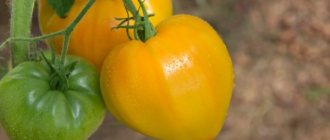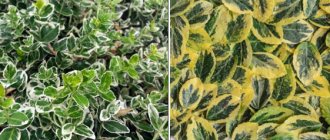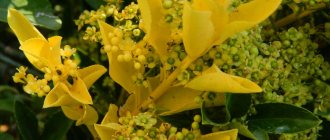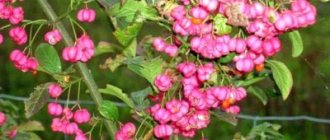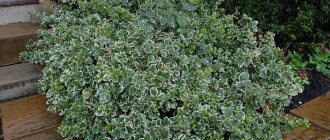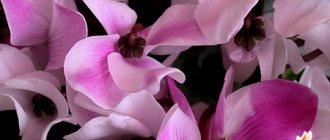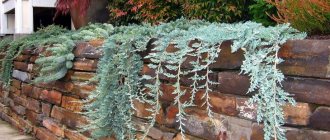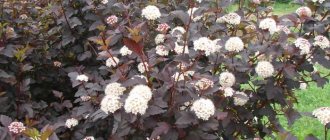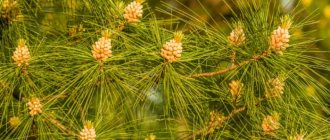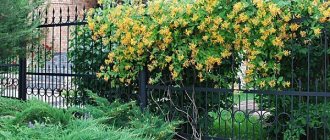General description of the plant
European euonymus is a bush or deciduous tree up to 3 m high , sometimes up to 5–8 m. The branches are tetrahedral; there are no warts, as in some varieties.
Places of growth
- Caucasus.
- Crimea.
- European part of Russia.
Note! Some specimens reach an age of 50 years or more. In the Askania-Nova Biosphere Reserve (Ukraine), an euonymus grows with a crown diameter of 6 m, a height of 4 m, and the age of the record holder is 62 years.
Flowering period – April – June . Small greenish-white flowers reach 10–12 mm.
The fruit is a four-plate capsule of a rich purple hue. After the fruits ripen, small seeds remain on thin threads.
The high decorativeness of leaves and bright fruits in the autumn explains the popularity of the shrub (tree) in landscape design. This variety of euonymus is often placed along hedges and fences .
Varieties
There are different varieties of European euonymus, which differ in minor features of appearance and growing conditions.
- Red Cascade
Crown diameter - 2.5 m. Height - 3.5 m. Flowering - May-June. How best to use: in group compositions, as a hedge, for single planting. It tolerates molding cutting and replanting well. Grows in full sun and partial shade.
- Intermedia
A distinctive feature of this variety is large dark green leaves and fairly voluminous fruits, which are not lost in the crown, but stand out favorably with their bright color against its background. It has highly decorative properties.
- Sherwood
This variety has a very interesting crown shape. It is almost perfectly spherical, since the shrub has the same height and diameter - up to 5 m. It grows intensively. Differs in crown density.
- Nana (Nana, Europaeus Nanus)
The most dwarf variety. A characteristic feature is creeping. Height - no more than half a meter. It has many branches that take root easily - this is how the plant reproduces naturally. Nana is distinguished from other representatives of this species by its foliage: it is not dull, but bright green, with a bluish base. The leaves themselves are as narrow as possible.
- Albus (Albus)
Height - 3 m. One of the fastest growing varieties: annual growth can be up to 60 cm. Its distinctive feature is white seeds, which, surrounded by red petals of the fruit, look equally decorative against the background of both dark green and bright purple foliage.
- Atropurpurea (Atropurpurea)
A low variety: on average, it grows no more than 2 m. It has all the features typical of European euonymus: small whitish flowers lost in the dark green dull foliage, and then a complete transformation in the fall: rich purple fruits and a bright red crown make the bush is a real decoration for any site.
Kinds
Euonymus has several varieties:
- unique winged;
- dwarf - ideal for growing at home;
- unpretentious warty;
- Japanese.
European euonymus: description and features
European euonymus is found growing wild in Western Europe, Russia (in the European part), the Caucasus and Crimea, and belongs to the Euonymus family. It can reach a height of 6 m in the form of a tree, shrubs grow on average up to 3 m. Young shoots of European euonymus are colored green, and with age they become almost black, and small growths appear on them. The wood is porous, yellowish, and turns white in air.
The leaves are dark green in color, about 10 cm in length, ovoid in shape, widening in the middle, framed by uniform teeth along the edge. During the growing season they are richly green; by autumn they change color from greenish-yellow to red and purple.
Flowering begins at the end of April-beginning of May and continues throughout June. The flowers are small, white, collected in semi-umbrella inflorescences. They are not particularly decorative and are lost against the background of the voluminous crown. In place of the flowers, fruit-boxes appear, which become red-orange as they ripen.
Euonymus has several varieties:
- unique winged;
- dwarf - ideal for growing at home;
- unpretentious warty;
- Japanese.
European euonymus in landscape design
Ornamental trees and shrubs of European euonymus are actively used in landscape design. They are planted singly or in groups. The plant is often used to make a hedge - it tolerates pruning well to give it shape.
Thanks to its bright color, European euonymus is also great as an accent. While some plants are still green and others have turned yellow or even lost their leaves, its red leaves add a touch of variety to the usual garden landscape.
The plant is often included in more complex compositions, in particular alpine slides. In combination with a decorative pile of piled stones, you get an interesting concept for an unusual flower bed, which stands out against the backdrop of smooth green lawns.
Photo
In the photo below you can appreciate the appearance of the European euonymus:
Use of euonymus in medicine, treatment with euonymus
- For cardiovascular failure, the seeds are used.
- For edema, gonorrhea and chronic constipation - infusion of euonymus branches.
- For fungal skin infections, use the leaves externally.
- For dry cough with difficult to separate sputum, malaria, edema and inflammatory diseases of the liver, a decoction of the fruit is prescribed.
- For dermatomycosis and eczema, fruit powder is used as an insecticidal and antiparasitic agent.
- For malaria, an infusion of the fruit is used as a laxative for constipation and malaria, as well as a sexual stimulant.
- Infusion and powder from the fruits and leaves are used internally as an anthelmintic, and externally for scabies, scabs and parasites (nits and lice).
Article on the topic: Gumai - beneficial properties, description
Planting and care at home
European euonymus has taken root well in gardens and parks. Urban conditions with increased gas pollution are not scary for the plant.
Gardeners know that if the conditions are met, euonymus blooms profusely and delights with bright leaves in the fall. A beautiful openwork crown with or without numerous flower tassels is highly decorative.
Important! The only caveat is that for increased decorativeness, a sufficient area of open space is required.
Care after purchase
Bring the seedlings home, place them in a cool place : let the roots rest slightly. Be sure to save some of the native soil in which the young bush previously grew. Make sure the ground is moist.
Trimming
The crown is formed in early spring or at the end of fruiting . Euonymus responds to pruning with rapid growth of young shoots.
The main shape of the crown is ellipsoidal or cone-shaped.
Gardeners often form a standard tree.
Important! Partial sanitary pruning is permissible during the growing season only for serious indications.
Carefully pinch the tops and remove weak shoots.
Watering
Euonymus prefers moderate soil moisture . With excessive watering, rotting of the roots and poor growth were noted. tolerates dry periods well .
Landing
The plant is planted in the ground in the spring ; autumn planting is less common. Choose a sunny place: in the shade, bruslina feels worse, the leaves lose their decorative properties.
How to proceed:
- dig a hole so that the root collar is at ground level;
- the size of the depression in the ground is one and a half times larger than the root system of the seedling;
- pour 10 cm of sand onto the bottom;
- add a mixture of peat, sand, turf soil (2:1:1);
- next layer – mineral fertilizers – 100 g plus slaked lime – 200 g. Optimal pH level – no more than 7.5;
- sprinkle the roots, tamp lightly, water moderately.
Note! After planting, the first four days require daily watering in moderate amounts.
Many gardeners plant a spindle tree not far from fruit plants: pests move to the ornamental leaf plant, forgetting about the apple trees. Maintain a distance sufficient for the free formation of the crown of neighboring trees or shrubs.
Transfer
The time has come to transplant the strong young seedlings into open ground.
The euonymus is transplanted to a permanent place for the 3rd year .
Choose a calm spring day when the soil is warm enough.
Planting rules are the same as for adult plants.
Care
Caring for the described plant is not difficult. The main thing is to carry out basic agrotechnical procedures on time and regularly, monitor soil moisture, and carry out preventive treatments of shrubs against ailments and parasites. It is especially important to provide the crop with proper care in the first week after planting.
Find out in more detail what euonymus is, its use, planting and care in landscape design.
Watering and fertilizing
In the first 7–10 days, the perennial requires frequent and abundant watering. Next, the bush should be watered, focusing on the condition of the soil - it should always be a little damp. During the dry season, the bush is moistened once a week. Under normal climatic conditions, irrigation activities are carried out no more than 1-2 times a month. When watering, it is very important to avoid excessive moisture, since excess moisture can cause rotting of the root system. Ideally, after each watering, it is recommended to loosen the soil around the plant. This procedure allows you to enrich the soil with oxygen and nutrients, thereby stimulating the development of roots.
The perennial is fed three times during the growing season using mineral complex fertilizers and organic matter. The first portion of nutrients is applied in early spring during the bud formation phase. At this time, organic means are used, for example, rotted manure diluted with water in a ratio of 1:10. The second time the bush is fed in the flowering phase, using complex fertilizers based on nitrogen. After the crop blooms, during the period of fruit ripening, a third portion of fertilizer is applied using potassium-phosphorus preparations.
Trimming and shaping
European euonymus is characterized by an intensive growth rate, develops quickly, and therefore requires regular pruning and shaping , to which it responds quite well. Every year, starting from the third year of crop growth, sanitary pruning is carried out, during which shoots that are broken after winter, infected, too weak or withered are removed.
After fruiting, a formative pruning is carried out, in which the bush is given a neat conical, ellipsoidal or oval shape. To maintain the desired shape of the crop, shoots are partially pruned throughout the growing season in order to thin them out and remove branches that stick out and fall out of the overall shape.
Important! The sap of the plant is toxic, so all work related to pruning shoots must be carried out using personal protective equipment: gloves, a special suit, goggles.
Preparing for winter
Until the age of 3 years, euonymus needs high-quality shelter for the winter. To do this, the shoots of the bush are tied with twine and covered with any breathable material - for example, burlap or agrofibre. Mature plants have good resistance to frost and can winter quietly at temperatures down to –25°C. To protect the root shoots from freezing, it is enough to cover the trunk circle with a thick layer of mulch in late autumn.
Growing
Euonymus requires sufficient light , neutral or slightly alkaline soil, and regular aeration. Clay soil, in addition to mineral and organic fertilizers, requires regular application of sand.
Immediately after watering, sprinkle the tree trunk circle with peat mulch. In autumn and spring, fertilize with mineral fertilizers once .
Important! The spindle tree does not tolerate salinity. Monitor the acidity of the soil, maintain a pH level of 6.6 to 7.5.
Landing
The optimal time for planting shrubs is spring or autumn. If your plans include growing euonymus in the garden and not in a pot, then you should worry about choosing the optimal location. Of course, the evergreen shrub is quite viable even in partial shade, but still, it is recommended to select an area that will be well illuminated by sunlight most of the day. It is important to take into account that the shrub grows greatly in width, so it needs to be planted away from other shrubs and trees. Neutral or slightly acidified soil is best suited for euonymus.
To plant a shrub, you will need to dig a hole that will be twice the size of the root system. In this case, the bottom should be covered with drainage made of pebbles and expanded clay. The soil should consist of deciduous soil, compost and sand. The seedling should be carefully placed so that the root collar ends up above the soil surface. It is important to ensure that there are no air pockets left in the soil.
To do this, you need to compact all layers well. After the plant is planted, it is recommended to water it daily for the first week.
Reproduction
The main type is the vegetative form :
- root suckers;
- dividing the bush;
- green cuttings.
Propagation by seeds requires more attention and patience. Under natural conditions, most of the seeds will germinate only in the second spring. Gardeners stratify seeds to speed up the germination process.
Stratification duration:
- first stage – 3–4 months at temperatures from +10 to +12 C;
- the second stage is 4–5 months, the temperature drops to 0…+3C.
Note! Seeds are sown in a specially designated place. The ideal soil composition is turf, sand, humus, leaf soil (1: 1: 2: 4).
In cool weather (autumn and spring), a layer of peat mulch is required. In winter, be sure to cover the young shoots with spruce branches.
Reproduction of European euonymus
European euonymus can be propagated in a variety of ways.
Cuttings
For cutting cuttings, select fully formed semi-lignified shoots from bushes no younger than 5 years of age. The best time for reproduction is late spring-early summer. Healthy strong branches are cut into cuttings 7-10 cm long with 1-2 internodes.
Germination is carried out under a film covering in pots or boxes with a peat-sand mixture. To speed up the process, pre-cuts can be treated with root formation stimulants. Keep the cuttings in a cool place with good lighting and periodically moisten the soil.
Rooting of European euonymus takes up to 2 months. After the roots appear, the plants can be transplanted into open ground.
Dividing the bush
Basal shoots that have reached a height of half a meter are planted, since such shoots already have well-formed roots. Dividing the bush is done in the spring, when the ground has warmed up sufficiently after the last frost.
The best result is obtained with basal shoots, the root of which is thicker than 1.5 cm and longer than 25 cm. The shoots are dug up without destroying the earthen ball and placed in a prepared hole or in a pot for growing.
Rooting by layering
If the European euonymus bush has low-lying young branches, then layering can be made from them. To do this, the shoot is bent, placed in a dug ditch, fixed and covered with fertile soil, leaving only the top.
In order for the root system to develop successfully, the soil must retain moisture well; for this, peat and sand are added to it. Root formation lasts 4-6 weeks, after which the cuttings are separated from the mother euonymus, dug up, and transferred to a permanent place in the garden.
Please note: young bushes are covered with fallen leaves or spruce branches before wintering. After 3 years of age, plants can overwinter without additional shelter.
Other methods of reproduction
European euonymus is also propagated by seeds, but this method is considered the most difficult and time-consuming. Stratification is required, carried out in two stages: first, the seeds are kept for 3 months at a temperature of about +10 °C, and then at a temperature of +3 °C.
European euonymus seeds are sown in a substrate of leaf soil, sand, humus and turf. Young seedlings are protected from frost until they become stronger.
Even root shoots are suitable for propagating euonymus, but for this you should choose only those shoots whose height has reached 40 cm. They are carefully separated from the mother plant in the spring and planted in a prepared place.
Benefits and harms
The spindle tree is used:
- in landscape design, as a soil-protective plant;
- herbalists, herbalists;
- high-quality wood is needed for making organ pipes , for wood carving, and engraving work;
- fatty oil is the basis for the production of high-quality natural soap ;
- the bark accumulates a high percentage of rubber-like gutta-percha;
- seed roofing, a decoction of the pods, is used to make paint ;
- loose charcoal from wood is used in inking pencils;
- The cake is sent to feed livestock .
Important! Bruslina does not harm neighboring trees and shrubs. One caveat - the carmine-red fruits are poisonous .
Types and varieties
Fortune's euonymus (Euonymus fortunei)
The evergreen shrub Euonymus fortunea grows 30-60 cm high, low or creeping. In nature, the Fortune species is not demanding; it grows in wet or swampy areas on the banks of streams. The plant can climb roots and stones to a height of up to 1.5 m. On hot days it requires a lot of water. In the Fortune culture, fertile, humus soil is better suited.
Varieties and varieties of Fortune:
- Coloratus is a fast-growing variety with large evergreen leaves. Resistant to diseases, pests, frost-resistant.
- Emerald Gaiety - this variety has small dark green leaves with a white edge. Forms a dense bush or carpet. Non-frost resistant.
- Emerald Gold is a bushy shrub with small, light green leaves edged with bright yellow. Non-frost resistant.
- Interbolwi - small yellow leaves with a dark border. Resistant to frost.
- Silver Queen - Large white-green leaves. The bush grows quickly. May freeze in winter.
- Sunspot - small leaves with a yellow center. Creates a green-yellow carpet. Frost-resistant.
Winged Euonymus (Euonymus alatus)
The bush rises to a height of 200-300 cm, forming an irregularly shaped bush. Grows well in sunny or slightly shaded areas. In summer it requires abundant watering. The leaf turns beautifully into strong shades of red.
European euonymus (Euonymus europaeus)
Shrub 150-600 cm high. In autumn the leaves become intensely red. Decorative fruits appear from inconspicuous flowers, hanging on the bushes. It can grow in partial shade, but then the leaves and seed sacs do not show as much color.
Flat petiolate (Euonymus planipes)
Grows up to 200 cm in height. In autumn the large leaves turn red. The flowers are inconspicuous, the fruits are interesting: red-pink bags on long stems and seeds in red “gloves”. Grows in all garden soils.
Warty (Euonymus verrucosa)
Rarely found, grows up to 250 cm in height, sparse shrub. The branches are covered with brown warts - hence the name. Black seeds hang from a red sac surrounded by a red shell.
Japanese (Euonymus japonicus)
A creeping evergreen shrub recommended for gardens with poor soil. Loves semi-shaded, even shady positions. It rises up to 400 cm in height, climbing walls and gazebos.
Diseases and pests
Euonymus attracts garden pests. Gardeners often use timber as a trap for harmful insects.
The spindle tree is often inhabited by:
- apple moth;
- hawthorn;
- aphid;
- caterpillars;
- spider mite;
- mealybug.
Major diseases
- trunk rot is a dangerous fungal disease that is difficult to treat. For prevention in the spring, treat the plant with 1% Bordeaux mixture. If the bruslin tissue is severely damaged, do not hesitate to burn the plant, otherwise the fungus will spread to healthy shrubs and trees;
- Powdery mildew is another disease that affects the spindle tree. Fungicides are required for control: Topaz, Previkur, Fundazol. The frequency of treatment is every other day until the disease is eliminated.
Description of euonymus
Sometimes the height of this plant reaches 4 m. The foliage is dark green, shiny, sometimes with creamy-silver spots in the center. Flowers with a not very pleasant smell, they are collected in inflorescences and brushes. It bears poisonous fruits; other parts of the plant should also not be eaten. You can view photos of all types of euonymus and descriptions on our website.
14
If you have chosen euonymus for your garden plot, you need to know that it is planted in early spring, sometimes in autumn. Don’t forget to carefully study the euonymus, learn about the planting features, and look at photos of the process. He likes to be in partial shade; the soil should be fertile, with good water permeability, and light. An important point is that the plant grows greatly in width and sometimes in height, so it should be planted away from trees, ensuring sufficient distance between the bushes and buildings on the site. Indoor varieties are planted in large pots and boxes; in summer it is better to leave them outside, and in winter they need to be brought into the house.
Euonymus with pink leaves looks amazing!
Euonymus can be grown in a pot
It is necessary to prepare a hole for planting plants in advance, about two weeks in advance. Make sure that the volume is 1.5 times greater than the root system of the seedlings. Place sand or a special composition for drainage at the bottom of the hole, cover with a layer of compost mixed with soil, then lower the plant seedling, straightening the roots, cover with a mixture of soil and compost, lightly tamping it down. If the euonymus will serve as a hedge, it is better to plant it in a trench. Naturally, after planting the plants, water them and do not forget to do this during the first week.
Preparing a hole for planting euonymus
Pests
There is an opinion among gardeners that the euonymus somehow attracts pests from other fruit trees to its crown. It is believed to function as an insect trap. Among the most common pests of this crop, it is worth noting scale insects, caterpillars, mealyworms, aphids, apple moths, and mites. The first signs of plant damage are curvature of young shoots, damaged or curled leaves. If you find these signs on the European euonymus, immediately treat the bush with insecticides. The following drugs provide good results in pest control: “Aktellik”, “Aktara”. When using Actellik, take 2 ml of the product, dilute it in 2 liters of water and spray the plants once a week. A total of 3 sprays will be needed.
Growing euonymus from seeds
Euonymus seeds photo
Reproduction is carried out by seeds and vegetative methods (cuttings, dividing the bush, layering, root shoots).
Sowing in the ground
It is better to sow freshly collected seeds in open ground before winter. The bed is prepared in advance, leveled, and the soil is allowed to settle. Make shallow furrows with a hoe or flat cutter at a distance of 20-30 cm. You need to sow less frequently, ideally at a distance of 8-10 cm. If this does not work, the seedlings will have to be thinned out. Mulch the crops with straw and leaves.
How to sow euonymus in the ground photo
In spring, the mulch is removed as early as possible so that the plants can break through. Don’t wait for it to get warm, otherwise the seedlings will trample or you will damage them when you rake the leaves. When the plants sprout, care will consist of weeding, loosening the soil and moderate watering. Grown seedlings are planted in a permanent place after 2-3 years and must be covered for the winter.
Growing seedlings
Euonymus from seeds photo seedlings
- To grow seedlings, the seeds must be kept in water for a couple of days and stratified for 3-4 months (keep them in a bag of wet sand in the vegetable section of the refrigerator).
- The seeds should swell well under such conditions. Carefully peel the seeds from the bursting dense skin, soak for 15 minutes in a weak solution of potassium permanganate, and rinse.
- Prepare boxes or cups with fertile garden soil and a small amount of sand; you can take ready-made soil for seedlings).
- The seeding depth is 2 cm.
- Cover the crops with film or glass.
- Expect the emergence of seedlings in 15-20 days, then remove the cover.
- A slight decrease in temperature to 18°C will be beneficial for the plants so that they do not stretch out. Provide good diffused lighting.
- Grown seedlings need to be hardened two weeks before planting in the ground. They can be planted in a training bed, and then transplanted to a permanent place when they reach a height of 25-30 cm. Be sure to cover them for the winter so that they do not freeze.
Reproduction by dividing the bush
How to divide an euonymus bush photo
It is most convenient to propagate dwarf species by dividing the bush, since their root system is located close to the soil surface. Cut off part of the rhizome along with above-ground shoots from the mother plant. Cut the shoots by 2/3, plant the cuttings in a permanent place.
Landing requirements
Before you start planting European euonymus, you need to purchase seedlings. This is best done at nurseries or garden centers. Please note: cross-pollination is necessary for fruit formation, so at least two bushes of this plant must grow in the garden plot. By the way, pollination will also occur if the euonymus grows in a neighboring area.
Any garden soil is suitable for growing bruslina. But it should still be noted: it grows better on drained fertile soils with a medium alkaline environment. If you want the European euonymus to be especially bright and expressive in autumn, the plants should be planted in a well-lit area. When grown in partial shade, the color of its outfit will not be as rich.
Experienced gardeners recommend planting in the fall, but it is not forbidden to do it in the spring. The planting hole is dug, taking into account the parameters of the root system. It is necessary to pour drainage (pebbles or river sand) at the bottom of the hole. We will prepare a soil mixture in advance consisting of turf soil, peat and sand. If the soil is not fertile enough, you can apply mineral fertilizers. You should make a mound from the soil mixture, place the roots on it, carefully straighten them and sprinkle the root system.
